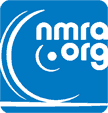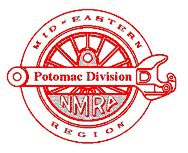


Hosting a Home Layout Tour
Try It. You Might Like It.
By Bob Rosenberg
One of the
advantages of being part of a large NMRA division is the potential of
a large number of home layouts within convenient travel range, and
the Potomac Division certainly has an abundance of capable, talented
modelers who have constructed some exceptionally realistic railroads.
A few of them have even earned national reputations for their
concepts and modeling skills, and have been featured in Model
Railroader Magazine. Unfortunately, there are also dozens of
additional layouts in our area that are not well known at all because
they’re only seen by the modeler’s immediate family or a
small circle of friends, and each of these “stealth”
layouts represents a missed opportunity for all of us, hosts and
visitors alike, to upgrade our model railroading knowledge and
expertise.
I can understand why someone might be reluctant to make their home layout available for a scheduled tour. They may think that they have too small a layout, too small a room, or even too small a house to accommodate the number of people that might materialize on a Sunday afternoon - all legitimate considerations because there are many of us that really enjoy attending these events. But l wonder, sometimes, if there isn’t also a more personal reason, a concern that our concepts or modeling skills might not be up to some mythical standard that we assume is expected by a group of serious and experienced contemporaries, and that our best efforts, no matter how hard we may have tried, will be seen by them as lacking or deficient in some way.
If that notion has discouraged anyone from hosting a tour, it would be a shame because in the 25 plus years that l’ve been the Potomac Division and its predecessor Dixie Division, I have never seen or heard negative comments expressed about the quality of anyone’s work. Having been the position of both a host and a visitor, my feeling is that most of us view a home layout tour as a learning opportunity, a sort of continuing education course on the various aspects of model railroading presented in an informal, relaxed home setting. I have never visited a layout, regardless of the size, the scale, or the abilities of the modeler, where l didn’t bring something home, one way or another, from the experience. Often I will see good ideas and, if they’re appropriate for my setting, will try to incorporate them into my own railroad. Occasionally l will see something that doesn’t quite work, and that can be useful too because I will, hopefully, not be inclined to repeat it. After visiting many home layouts and observing what other people had done, l was encouraged to get back to work my own railroad. Maybe, if l had visited your railroad (yes, you, the one who hasn’t yet extended us an invitation), I might have seen an easier way to solve a problem, or avoided one of my major disasters. Multiply that by the number of members in the Potomac Division and you’d almost be performing a public service by having us come by and share your accomplishments.
So why not give it a try. In model railroading size is not important, and no elaborate preparations are necessary, either. All that you really need is some track, a train or two (preferably running), some soft drinks and a bowl of chips. A railroad video on the VCR might be nice, too. Sixty people came to my home in October on one of the Mid-East Region Convention tours, and I can say from personal experience that nothing makes your day like a room filled with admiring, appreciative model railroaders.
I can understand why someone might be reluctant to make their home layout available for a scheduled tour. They may think that they have too small a layout, too small a room, or even too small a house to accommodate the number of people that might materialize on a Sunday afternoon - all legitimate considerations because there are many of us that really enjoy attending these events. But l wonder, sometimes, if there isn’t also a more personal reason, a concern that our concepts or modeling skills might not be up to some mythical standard that we assume is expected by a group of serious and experienced contemporaries, and that our best efforts, no matter how hard we may have tried, will be seen by them as lacking or deficient in some way.
If that notion has discouraged anyone from hosting a tour, it would be a shame because in the 25 plus years that l’ve been the Potomac Division and its predecessor Dixie Division, I have never seen or heard negative comments expressed about the quality of anyone’s work. Having been the position of both a host and a visitor, my feeling is that most of us view a home layout tour as a learning opportunity, a sort of continuing education course on the various aspects of model railroading presented in an informal, relaxed home setting. I have never visited a layout, regardless of the size, the scale, or the abilities of the modeler, where l didn’t bring something home, one way or another, from the experience. Often I will see good ideas and, if they’re appropriate for my setting, will try to incorporate them into my own railroad. Occasionally l will see something that doesn’t quite work, and that can be useful too because I will, hopefully, not be inclined to repeat it. After visiting many home layouts and observing what other people had done, l was encouraged to get back to work my own railroad. Maybe, if l had visited your railroad (yes, you, the one who hasn’t yet extended us an invitation), I might have seen an easier way to solve a problem, or avoided one of my major disasters. Multiply that by the number of members in the Potomac Division and you’d almost be performing a public service by having us come by and share your accomplishments.
So why not give it a try. In model railroading size is not important, and no elaborate preparations are necessary, either. All that you really need is some track, a train or two (preferably running), some soft drinks and a bowl of chips. A railroad video on the VCR might be nice, too. Sixty people came to my home in October on one of the Mid-East Region Convention tours, and I can say from personal experience that nothing makes your day like a room filled with admiring, appreciative model railroaders.